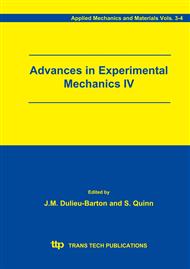[1]
R. Szilard, Theory and Analysis of Plates (Prentice-Hall, Inc, 1974).
Google Scholar
[2]
A. W. Leissa, Vibration of Plates, NASA SP-160, Washington, DC, U. S (Government Printing Office, 1969).
Google Scholar
[3]
ASTM Standard E1875-00e1. Standard Test Method for Dynamic Young's Modulus, Shear Modulus, and Poisson's Ratio by Sonic Resonance (Book of Standards Volume 03. 01, 2003).
DOI: 10.1520/e1875-00e01
Google Scholar
[4]
ASTM Standard E1876-01. Standard Test Method for Dynamic Young's Modulus, Shear Modulus, and Poisson's Ratio by impulse Excitation of Vibration. (Book of Standards Volume 03. 01, 2001).
DOI: 10.1520/e1876-01
Google Scholar
[5]
L.R. Deobald, R. F. Gibson, Determination of elastic constants of orthotropic plates by modal analysis/Rayleigh-Ritz technique, Journal of Sound and Vibration 124 (1988) 269-283.
DOI: 10.1016/s0022-460x(88)80187-1
Google Scholar
[6]
R. Rikards, A. Chate, W. Steinchen, A. Kessler, A.K. Bledzki, Method for Identification of Elastic Properties of Laminates based on Experiment Design, Composites: Part B 30 (1999) 279-289.
DOI: 10.1016/s1359-8368(98)00059-6
Google Scholar
[7]
P. Pedersen, P.S. Frederiksen, Identification of Orthotropic Material Moduli by a Combined Experimental/Numerical Method, Measurement 10 (1992) 113-118.
DOI: 10.1016/0263-2241(92)90003-m
Google Scholar
[8]
C. Maletta, L. Pagnotta, Determining material properties in anisotropic plates using genetic algorithms and vibration test data, International Journal of Mechanics and Design 1 (2004) 199-211.
Google Scholar
[9]
D. Young, Vibration of rectangular plates by the Ritz method, Journal of Applied Mechanics 17 (1950) 448-453.
DOI: 10.1115/1.4010175
Google Scholar
[10]
G.B. Warburton, The vibration of rectangular plates, Proceedings of the Institution of Mechanical Engineers 168 (1953) 371-384.
Google Scholar
[11]
A. W. Leissa, The free vibration of rectangular plates, Journal of Sound and Vibration 31 (1973) 257-293.
DOI: 10.1016/s0022-460x(73)80371-2
Google Scholar
[12]
G.W. Caldersmith, Vibration of orthotropic rectangular plates, Acustica 56 (1984) 144-152.
Google Scholar
[13]
Grant Sitton, MSC/NASTRAN Basic Dynamic Analysis User's Guide. (The MacNealSchwendler Corporation, U.S.A., 1997).
Google Scholar
[14]
M. Alfano, L. Pagnotta, L. Bruno, Determinazione delle costanti elastiche di piastre quadrate isotrope dalle frequenze naturali di vibrazione, Proc. XXXII Conference of the Italian Association for Stress Analysis (AIAS), in italian, Salerno, (2003).
Google Scholar


